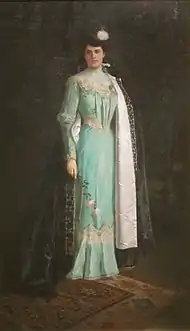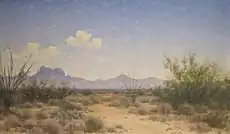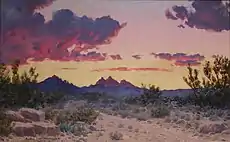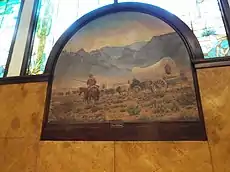Audley Dean Nicols
Audley Dean Nicols (1875–1941[1]) was an American artist, illustrator and muralist. Born and raised in Pittsburgh, he studied in New York and Europe, and worked as an illustrator for various national magazines. He moved to El Paso, Texas, in the 1920s for health reason where he achieved success painting desert landscapes of the Southwest. Nicols achieved national recognition during his lifetime, with his style and choice of subjects gathering followers who became known as the "Purple Mountain Painters".
Audley Dean Nicols | |
|---|---|
| Born | 1875 |
| Died | 1941 (aged 65–66) El Paso, Texas, US |
| Alma mater | Art Students League of New York |
| Known for | Desert landscape painting |
Life and career

Audley Dean Nicols was the son of Parshall D. Nicols, an iron broker, and Elizabeth Agnes McLaughlin, an art teacher. His brother, Lowell W. Nicols, was an art critic and optical glass research chemist.[2]
Nicols received his first art lessons from his mother, subsequently studying in New York at the Metropolitan Museum of Art and the Art Students League of New York under Harry Siddons Mowbray, Edwin Blashfield, and Kenyon Cox.[1][3] After further studies in Europe he started a career as a magazine illustrator, working for several publications such as Collier's, McClure's, Cosmopolitan, Harper's, Scribner's, and The Burr McIntosh Monthly.[3][4][5] He then moved to oil painting, working from a studio in Sewickley, Pennsylvania.[6]
Nicols began visiting and exhibiting in Texas from around 1919, permanently moving to El Paso with his family in 1922,[7] due to health issues with a tubercular hip.[3][8] He lived in a house in Fort Boulevard at the foothills of the Franklin mountains, going into long desert expeditions for plein air painting.[9] Nicols' work includes murals in Pittsburgh public buildings,[10] and large paintings such as the 6-by-7-foot (1.8 by 2.1 m) Cave creek canyon at the lobby of the Gadsden Hotel in Douglas, Arizona.[11] He painted General Alexander Hays in a portrait[12] and in a now lost painting where he is shown dragging the Confederate flag from his horse.[13] A 1902 portrait of his sister Alice Clyde Nicols also survives.
Nicols painted desert panoramas of Texas, Arizona, New Mexico, and California. His 1927 depiction of Tokay, a former coal-mining settlement in Socorro County, New Mexico, is considered a valuable historical record of what is now a ghost town.[14] In 1927 a lithograph reproduction of a painting of Texas' El Capitan peak by Nicols was distributed as a publicity campaign for the Texas and Pacific Railway line.[15]
In 1932 he was hospitalized for several weeks due to a brain hemorrhage but eventually recovered.[16]
The artist was characterized as eccentric and mysterious, but had a circle of close friends including General Robert L. Howze.[17][9] He was married to Mary Nicols and had two children, Audley Dean Jr and Mary Beth.[18] After a long illness he died in November 1941, with the artist Tom Lea, who was also Mary Beth's godfather,[19] as one of the pallbearers.[20] He is buried in Restlawn Memorial Park in El Paso.
Style and legacy
Nicols' style of clean, detailed landscape painting was inspired by the clarity, sharp lines and strong contrasts of the desert, and applied color techniques to hint at the vast expanses while maintaining details.[21][22] His depiction of the distinctive nature of desert light has also been recognized by critics as one of the best.[7] The compositions are often organized in three horizontal sections: the desert ground and vegetation below, mountains in the middle, and the sky above. He depicted vibrant nature scenes with only few and small traces of humans, if any, using warm light and vivid colors, such as bluish purple for the distant mountains.[23] The style and subjects of Nicols' work achieved significant popularity, and were followed by other West Texas artists, who became known by the nickname of "Purple Mountain Painters".[23][21] He was a friend of other local artists such as Fremont Ellis and Lewis Teel, and encouraged Eugene Thurston to start painting.[24]

Nicols is considered an important early Texas artist, especially known for his large-scale portrayals of the desert scene.,[25] although he also used other subjects, for example participating in the San Antonio wild flower competition.[26] Nicols' work "View of El Paso at Sunset" was included in the 2019 major exhibition "The Art of Texas: 250 Years" at the Witte Museum in San Antonio.[17][27] This 22-foot (6.7 m) painting had been commissioned by an El Paso bank in 1925; when the bank closed in 1933, a local resident purchased it and donated it to El Paso High School.[19] It remained on display at the school library until 1972, when it was taken down for restoration; during renovations of the school in 2000,[19] it was discovered in a janitor's closet.[28] Nicols achieved national recognition during his lifetime, with his paintings helping to romanticize the Southwest and included in several private and public collections, including the White House during the Warren G. Harding administration (1921-1923).[7] Currently, works by Nicols are part of the permanent collections of museums such as the Phoenix Art Museum, Tucson Museum of Art, and El Paso Museum of Art.[29][30]
Paintings
 Sunland landscape (1923), El Paso Museum of Art
Sunland landscape (1923), El Paso Museum of Art Arizona landscape (1920s), Phoenix Art Museum
Arizona landscape (1920s), Phoenix Art Museum Cave creek canyon (1907), Gadsden Hotel, Douglas, Arizona
Cave creek canyon (1907), Gadsden Hotel, Douglas, Arizona
References
- Grauer, Paula L.; Grauer, Michael R. (1999). Dictionary of Texas artists, 1800-1945. Internet Archive. College Station: Texas A&M University. p. 70. ISBN 978-0-89096-861-1.CS1 maint: date and year (link)
- "Obituary: Lowell W. Nicols". Pittsburgh Post-Gazette. August 2, 1940. p. 5. Retrieved January 21, 2021.
- "Audley Dean Nicols Biography". Taos and Santa Fe Painters. Archived from the original on December 1, 2020. Retrieved December 1, 2020.
- Burr McIntosh Monthly 1903-07, December 14, 2018, retrieved December 2, 2020
- Halff, Harry (2017). "Audley Dean Nicols". Harry Halff Fine Art. Archived from the original on December 2, 2020. Retrieved December 2, 2020.
- "Correspondence". Smithsonian Institution. Carnegie Institute, Museum of Art records. Archived from the original on January 21, 2021. Retrieved January 21, 2021.
- "El Paso High School to restore historic painting of the area". El Paso Times. January 9, 1972. p. 94. Retrieved January 22, 2021.
- "Audley Dean Nicols Paintings". Charles Morin's Vintage Texas Gallery. 2020. Archived from the original on December 2, 2020. Retrieved December 2, 2020.
- "Audley Dean Nicols". Fine Arts of Texas Inc. 2020. Archived from the original on December 5, 2020. Retrieved December 5, 2020.
- Samuels, Peggy; Samuels, Harold (1985). Samuels' encyclopedia of artists of the American West. Internet Archive. Secaucus, N.J. : Castle. ISBN 978-1-55521-014-4.
- "History". The Gadsden. March 3, 2017. Archived from the original on December 2, 2020. Retrieved December 2, 2020.
- Gorczyca, Robert (2003). "The Civil War letters of Brigadier General Alexander Hays". Western Pennsylvania History. 86 (1): 10–24.
- Butko, Brian (2003). "The famous, missing painting". Western Pennsylvania History. 86 (1): 25.
- Hook, Stephen C. (June 2015). "Then and Now—A Brief History of Tokay, New Mexico" (PDF). New Mexico Geology. 37 (2): 47–51. Archived from the original (PDF) on January 18, 2021.
- "Railroad uses Texas painting to advertise". El Paso Evening Post. November 20, 1929. p. 10. Retrieved January 21, 2021.
- Turner, Jack (September 1, 1932). "Famous artist tells of reaction when near death". El Paso Times. Retrieved January 18, 2021.
- Fowler, Gene (August 23, 2019). "The Whole Enchilada: 250 Years of Texas Art at the Witte Museum". Glasstire. Archived from the original on December 5, 2020. Retrieved December 5, 2020.
- "Engagement of Miss Nicols, Ronald F. Morrison announced". El Paso Times. April 29, 1951. p. 31. Retrieved January 18, 2021.
- Sanchez, Sara (February 5, 2019). "An El Paso treasure that spent time in a janitor's closet now hangs in art museums". El Paso Times. Retrieved January 20, 2021.
- "El Paso artist taken by death". El Paso Times. November 14, 1941. p. 12. Retrieved January 19, 2021.
- Sommer, Elisabeth W. (September 8, 2017). "El Paso Museum of Art Audio Guide Labels". The Museum Doctor. Archived from the original on December 8, 2020. Retrieved December 8, 2020.
- Galaviz, Lisa; Talusani, Sarita (May 2005). "Visions of Texas: Exploring early Texas art" (PDF). Center for the Advancement and Study of Early Texas Art. Archived from the original on December 8, 2020. Retrieved December 8, 2020.
- Gerstheimer, Christian J. (2010). Leach, Dorothy Ann (ed.). Into the desert light: Early El Paso art 1850−1960. El Paso, TX: El Paso Museum of Art. pp. 12–21. ISBN 0-9785383-3-1.
- Zanetell, Myrna (February 17, 2013). "3 generations of El Paso Art". El Paso Inc. Archived from the original on January 22, 2021. Retrieved January 22, 2021.
- "Audley Dean Nicols Painting View of El Paso at Sunset". El Paso Times. February 1, 2019. Archived from the original on December 5, 2020. Retrieved December 5, 2020.
- Lilly, Marie Seacord (1929). "The Texas wild flower painting competitions". The American Magazine of Art. 20 (6): 342–347. ISSN 2151-254X – via JSTOR.
- Hart, Alexandra (May 13, 2019). "Seeing Texas History Through An Artistic Lens". Texas Standard. Archived from the original on December 5, 2020. Retrieved December 5, 2020.
- Cascone, Sarah (February 6, 2019). "A Long-Lost Classic of Texas Art Was Found in a Janitor's Closet—and Now It's Getting Its Own Museum Show". artnet News. Archived from the original on December 5, 2020. Retrieved December 5, 2020.
- "Object Record". Tucson Museum of Art. 2016. Archived from the original on December 4, 2020. Retrieved December 4, 2020.
- "Object record". El Paso Museum of Art. Archived from the original on December 4, 2020. Retrieved December 4, 2020.
External links
| Wikimedia Commons has media related to Audley Dean Nicols. |